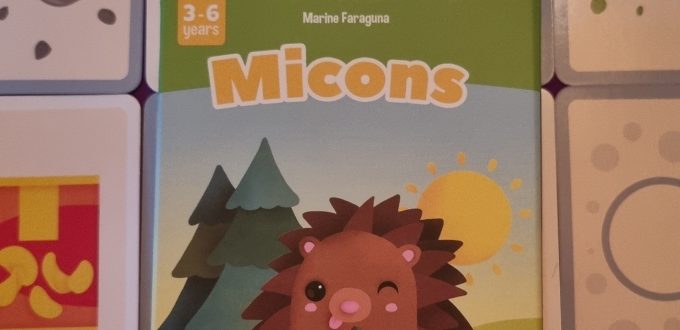Publisher: Gigamic and Hachette Board Games UK
Designer: Marine Faraguna
Illustrator: Elen Lescoat
2-4 Players
Age: 3- 6 years
15 mins
Favouritefoefunlearning score: 8/10
Candle…..light…..sun……hot…….thermometer……..
Word association is a long practised pastime on car journeys in our family. Spot something. Say it. Suggest something associated to it. See how long the chain can go! I prefer it to ISpy and is infinitely more enjoyable than singing “10 Green Bottles”.
But what if your vocabulary isn’t very big yet? To see an object as it passes your window, name it, make a link to another object, and then name that can be a tricky and frustrating exercise for the littlest gamers amongst us.
Well, Micons by Gigamic could be the solution. This little box of 50 double-sided cards is a visual game of associations, using pictures instead of words. And its target audience are the growing gamers aged 3 – 6 years
And set up is as sweetly simple as the illustrations and game play. With each player having 5 cards face up in front of them, each turn you will be trying to link one of your cards to the picture shown in the centre deck. The cards in your hand show their white edges face up, whilst the object to be linked has the blue edge side visible.
And so, each round, you will look at your cards and decide if any of them share a characteristic with the centre card. If you think one does, say the link, and lay it on top with the blue edge side up. That way, the reverse side of your card becomes the object for the next player to link to one of their own cards. If you can’t lay a card, you must draw one from the deck and add it to your open hand. The first person to get rid of all their cards is the winner.
Categories are wide; hot, salty, yellow, sweet etc. and the objects are easy to recognise; candle, flower, carrot, snowman etc. On that basis, little ones get the satisfaction of recognising and linking what they see to each other on many of their turns. Plus there are a few wild cards which can be placed on anything in order to get players out of sticky spots.
But, a link isn’t always obvious, and so interpretation as well as imagination and skills of persuasion are put to good effect. For example, although the fire engine isn’t “hot” in and of itself, it does put out flames, which could be a plausible and successful association. And in Micons, democracy is the deciding factor; if the other players agree, the card goes down. If you don’t argue your case sufficiently, you don’t get to lay it.
Although Mini-meeple has a considerable vocabulary now, he found this game fun. Plus, because he is a little further on in his development, he found himself thinking of quite esoteric links simply because he is now more aware of the world around him. I hadn’t expected him to link salty and snowman, for example. But he remembered the salt bins on the roadside back in winter, and how those grains were used to lower the freezing point of water, thereby melting the ice. Of course, this level of connection would be beyond most (if not all!) 3 year olds, but it does demonstrate the versatility of the game, which is great when you have differently abled players. Absent cards scaled in difficulty, it does offer opportunities for house rules/added restrictions to up the ante for the older ones.
I would say that we were initially a little confused by a few of the categories. I thought the sugar cubes were ice blocks, and the blue splatter water, but a quick rules check clarified the illustrations. Similarly, a depiction of a square is apparently wide enough to incorporate rectangles, which isn’t immediately obvious, and opens up a lot more opportunities to make links between cards which could reduce the challenge for those towards the upper age limit.
Overall, however, this is a sweet, developmental game that is portable and fast enough to engage even the smallest gamers amongst us. I would go as far as saying that it is a #gameschooling sure-thing for parents and teachers of the target audience. After all, as knowing what something is or does often comes before being able to say its name, Micons celebrates and rewards that visual memory and cognitive link. Not only that but it gives ample opportunity to practice the names of the objects on the cards; 50 times over in fact!





